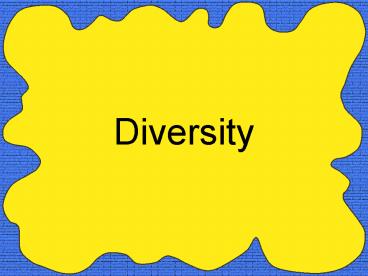Diversity - PowerPoint PPT Presentation
1 / 19
Title:
Diversity
Description:
TOPIC A: Develop an official statement for the CoC to use about the value of ... Avoid sexist language in classroom discussions, lectures, and in written ... – PowerPoint PPT presentation
Number of Views:37
Avg rating:3.0/5.0
Title: Diversity
1
Diversity
2
Building a positive climate for diversity in CoC
- Definitions
- Why important to computing
- Snapshot of CoC goals for diversity
- Role of communication in making a difference
- Implications for your work with students
- Resources for you..
3
- TOPIC A Develop an official statement for the
CoC to use about the value of diversity in
computing. - TOPIC B What kind of diversity do you expect to
see in GTs CoC classrooms?
4
CoC Student Diversity
1352 undergrad students 486 grad students (208
MS, 278 PhD)
- African American 5
- Asian 28
- Caucasian 67
- Hispanic 2
- Other ethnicities 1.1
- Female 12
5
3 times more international grad students than
undergrads
- CoC - GT
- Grads 47.5
- Undergrads 16
6
- Blind Admissions Process at GT
- So
7
In terms of ability all new GT freshmen are in a
level playing field upon entry
- Mean high school gpa 3.74 (3.69)
- Mean SAT 1336 (1366)
8
Fall 2003 freshman class
- Certain of grad school 47
- Certain/very certain of major 73
- Commuters 7
- Working Part-time 21 (14)
- Valedictorian 10 (3)
- First Generation 27 (9)
9
Hispanic and AA Trends Are Low and Steady
- National CS Bachelors Recipients
- 2002 2001 2000 1999
- African Americans 3 3 4 4
- Hispanics 4 4 3 4
- 2001-2 CRA Taulbee Survey
10
CoC Under-Represented Undergrads
- CoC F02 1stYr
F03 GT - African Americans 5 4
6 6 - Hispanics 2 3
3 3
11
Degrees Awarded to Women Nationally Changes
from 1993 to 2000
- Math/Stats ? 8.9
- Bio/Life Sciences ? 20.7
- Engineering ? 38.3
- Physical Sciences ? 44.6
- Computer Science ? 24.5 (still dropping)
12
CoC is significantly low in enrollment of
undergraduate women in comparison to national
averages
- CS-BS U.S. degrees awarded to women in 2002 24
- CoC BS-CS degrees 10
- Retention of women in CS is lower than men - same
true for minorities
13
Our challengesTo ensure that CoC climate and
curriculum is supportive and responsive to all
students. At the same time we must develop a
recruiting plan to educate students about
computing.
14
- Classroom Dynamics
15
Our Filters..
- We all come to the table with multiple realities
and identities.
16
Impact for you as a TA?
- Flash judgements
- Hidden biases
- Assumptions
- Gender differences in the classroom
- Cultural differences in communication
- Learning style differences
- Potential outcome differences for different
students
17
Use new NSF web resource on gender and race
equity in computer science and information
technologyhttp//www.josanders.com/portal/index.
htmhttp//www.josanders.com/equitytext/mod4_07.ht
m
18
General Principles for Teaching All Students
- Don't overlook capable but quiet students.
- Give male and female students equal attention in
advising and mentoring - Give female and male students equal attention and
equally specific feedback. - Monitor classroom dynamics to ensure that
discussion does not become dominated by more
aggressive students.
19
- Vary the classroom structure to include more than
just competitive modes of learning. - Revise curricula if necessary to include female
experiences, and to include them in more than
just stereotypical ways. - Increase wait time the amount of time you allow
for students to formulate an answer to a question
in class.
20
- Avoid sexist language in classroom discussions,
lectures, and in written materials that you
distribute to the class. - Do not ask female students to perform activities
you would not request of male students or vice
versa. - Adapted from Teaching a Diverse Student Body (p.
9), by N. Loevinger, 1994, University of
Virginia.
21
Stay Involved with the Topic
- CoC Diversity Advisory Board 11/13
- Joanne McGrath Cohoon - Faculty role in
increasing retention of women in CS lunch 11/13 - Input into development of materials to be used to
recruit - Unlocking the Clubhouse Fisher and Margolis
- Achieving Gender Equity in Science Classrooms, A
Handbook for Faculty - Brown Univeristy, et al.
22
- Our goal is to become known as the place for
diversity in computing education. - Significant increase in women and other
underrepresented minorites. - We can do this with your support.































